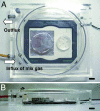Effects of light on development of mammalian zygotes
- PMID: 17709739
- PMCID: PMC1964859
- DOI: 10.1073/pnas.0706687104
Effects of light on development of mammalian zygotes
Abstract
It is generally assumed that light has no effect on the physiology of oocytes, zygotes, or early embryos. Therefore, little or no attention has been paid to lighting conditions during the handling of these cells in vitro. Here we show that cool white fluorescent light, rich in short-wavelength visible light and commonly used in research and clinical laboratories, produces more reactive oxygen species in mouse and hamster zygotes than does warm white fluorescent light. Mouse blastocysts that developed from zygotes shielded from light best developed to term fetuses followed by those exposed to warm white fluorescent light and then by those exposed to cool white fluorescent light. We hypothesized that light is one of the physical factors affecting embryonic environment and that its effects on cultured mammalian zygotes and embryos should not be overlooked.
Conflict of interest statement
The authors declare no conflict of interest.
Figures





Comment in
-
Of light and mouse embryos: less is more.Proc Natl Acad Sci U S A. 2007 Sep 11;104(37):14547-8. doi: 10.1073/pnas.0707142104. Epub 2007 Sep 4. Proc Natl Acad Sci U S A. 2007. PMID: 17785409 Free PMC article. No abstract available.
Similar articles
-
Expression of a reporter gene after microinjection of mammalian artificial chromosomes into pronuclei of bovine zygotes.Mol Reprod Dev. 2001 Dec;60(4):433-8. doi: 10.1002/mrd.1107. Mol Reprod Dev. 2001. PMID: 11746953
-
Culture of zygotes increases TRP53 [corrected] expression in B6 mouse embryos, which reduces embryo viability.Biol Reprod. 2007 Mar;76(3):362-7. doi: 10.1095/biolreprod.106.056838. Epub 2006 Nov 8. Biol Reprod. 2007. PMID: 17093197
-
Different preferences of IVF and SCNT bovine embryos for culture media.Zygote. 2014 Feb;22(1):1-9. doi: 10.1017/S0967199412000184. Epub 2012 Jul 11. Zygote. 2014. PMID: 22784408
-
Fetal development of mouse oocytes and zygotes cryopreserved in a nonconventional freezing medium.Cryobiology. 2002 Feb;44(1):5-13. doi: 10.1016/S0011-2240(02)00007-X. Cryobiology. 2002. PMID: 12061843
-
Do the fastest concepti have a shorter life span?Hum Reprod. 1997 May;12(5):885-9. doi: 10.1093/humrep/12.5.885. Hum Reprod. 1997. PMID: 9194634 Review.
Cited by
-
The effect of discrete wavelengths of visible light on the developing murine embryo.J Assist Reprod Genet. 2022 Aug;39(8):1825-1837. doi: 10.1007/s10815-022-02555-4. Epub 2022 Jun 23. J Assist Reprod Genet. 2022. PMID: 35737174 Free PMC article.
-
Light-induced injury in mouse embryos revealed by single-cell RNA sequencing.Biol Res. 2019 Aug 29;52(1):48. doi: 10.1186/s40659-019-0256-1. Biol Res. 2019. PMID: 31466525 Free PMC article.
-
Role of Antioxidants in Assisted Reproductive Techniques.World J Mens Health. 2017 Aug;35(2):77-93. doi: 10.5534/wjmh.2017.35.2.77. Epub 2017 Apr 30. World J Mens Health. 2017. PMID: 28497913 Free PMC article. Review.
-
Could oxidative stress influence the in-vitro maturation of oocytes?Reprod Biomed Online. 2009 Jun;18(6):864-80. doi: 10.1016/s1472-6483(10)60038-7. Reprod Biomed Online. 2009. PMID: 19490793 Free PMC article. Review.
-
Long-Term Effects of ART on the Health of the Offspring.Int J Mol Sci. 2023 Sep 1;24(17):13564. doi: 10.3390/ijms241713564. Int J Mol Sci. 2023. PMID: 37686370 Free PMC article. Review.
References
Publication types
MeSH terms
Substances
LinkOut - more resources
Full Text Sources
Other Literature Sources

